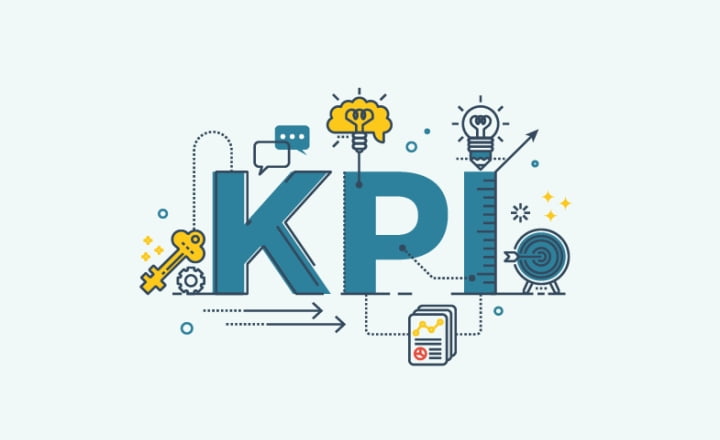Digital marketing is a powerful tool for businesses to reach their target audience and drive growth. But how can you measure the effectiveness of your digital marketing efforts?
That’s where Key Performance Indicators (KPIs) come into play. KPIs help you track and evaluate the metrics that matter the most to your business, providing valuable insights into your marketing performance.
In this complete guide to digital marketing KPIs, we’ll explore everything you need to know about tracking and measuring the success of your digital marketing campaigns.

Table of Contents
- What are Digital Marketing KPIs?
- Why You Need to Track Your KPIs
- How to Track Your KPIs for Digital Marketing
- The Most Important Digital Marketing KPIs
- How to Choose the Right KPIs to Track
- Top Digital Marketing KPIs to Measure in 2024
- Conclusion
What are Digital Marketing KPIs?
Digital marketing KPIs, or Key Performance Indicators, are quantifiable metrics that help businesses evaluate their digital marketing performance.
These metrics provide insights into the success or failure of marketing campaigns and strategies. By tracking KPIs, businesses can identify areas of improvement, measure the impact of their marketing efforts, and make informed decisions to optimize their digital marketing strategies.
Why You Need to Track Your KPIs
Digital Marketing KPIs are the key performance indicators that help you measure the success of your online marketing efforts. By tracking these KPIs, you can get valuable insights into the effectiveness of your campaigns and make data-driven decisions to optimize your strategy.
Imagine being able to see exactly how many people are visiting your website, how long they’re staying, and which pages they’re interacting with the most.
With digital marketing KPIs, you can do just that! You can track metrics like website traffic, bounce rate, conversion rate, and more. These insights are like gold for marketers, as they provide a clear picture of what’s working and what’s not.
Armed with this information, you can tweak your tactics and optimize your content to drive even better results. It’s like having a crystal ball that reveals exactly what’s working and what needs improvement.
How to Track Your KPIs for Digital Marketing
Tracking digital marketing KPIs requires the right tools, a well-defined tracking system, and a robust monitoring and analysis process.
Choosing the Right Tools
There are numerous tools available that can help businesses track their digital marketing KPIs effectively. These tools range from comprehensive analytics platforms like Google Analytics to specialized tools for social media management, email marketing, and SEO tracking.
Businesses should choose tools that align with their specific needs and objectives, ensuring they have access to the necessary data and insights.
Setting Up Your Tracking System
Once the tools are in place, businesses need to set up a tracking system to collect and organize the relevant data. This involves implementing tracking codes or scripts on websites, integrating platforms and tools, and configuring the tracking settings.
It is essential to ensure that the tracking system captures accurate and comprehensive data to provide meaningful insights.
Monitoring and Analyzing Your KPIs
Monitoring and analyzing digital marketing KPIs is an ongoing process. Businesses should establish a regular cadence for reviewing and analyzing the data, whether it’s daily, weekly, or monthly.
This allows businesses to identify trends, patterns, and anomalies and take immediate action if needed. It is crucial to have a dedicated team or individual responsible for monitoring and analyzing the KPIs to ensure timely and accurate insights.
The Most Important Digital Marketing KPIs
Digital marketing encompasses various channels and strategies, each with its own set of KPIs. Here are some of the most important digital marketing KPIs businesses should track:
Search Engine Optimization (SEO) KPIs
- Organic Traffic: the number of visitors from search engine results pages.
- Keyword Rankings: the position of a website for specific keywords.
- Backlinks: the number of external websites linking to a website.
- Bounce Rate: the percentage of visitors who leave a website after viewing only one page.
- Domain Authority: a measure of a website’s authority and credibility.
General Marketing KPIs
- Customer Lifetime Value (CLV): the total value a customer generates over their lifetime.
- Customer Acquisition Cost (CAC): the cost of acquiring a new customer.
- Return on Investment (ROI): the profitability of marketing campaigns.
- Conversion Rate: the percentage of website visitors who take a desired action.
- Lead Generation: the number of qualified leads generated.
- Brand Awareness: the level of awareness and recognition of a brand.
Paid Advertising (PPC) KPIs
- Cost per Click (CPC): the average cost of each click on an advertisement.
- Click-Through Rate (CTR): the percentage of people who click on an advertisement.
- Conversion Rate: the percentage of ad clicks that result in a desired action.
- Return on Ad Spend (ROAS): the revenue generated for every dollar spent on advertising.
Social Media KPIs
- Follower Growth Rate: the rate at which social media followers increase.
- Engagement Rate: the level of interaction and engagement on social media posts.
- Reach the number of unique users who see social media content.
- Clicks: the number of clicks on links or advertisements on social media platforms.
Email Marketing KPIs
- Open Rate: the percentage of email recipients who open an email.
- Click-Through Rate (CTR): the percentage of email recipients who click on a link in an email.
- Conversion Rate: the percentage of email recipients who complete a desired action.
- Bounce Rate: the percentage of undeliverable emails.
These are just a few examples of digital marketing KPIs, and businesses should choose the ones that are most relevant to their specific marketing strategies and goals.
How to Choose the Right KPIs to Track
Choosing the right digital marketing KPIs involves aligning them with your business goals and ensuring they meet the SMART criteria.
Aligning KPIs with Business Goals
Every business has unique goals and objectives when it comes to its digital marketing efforts. It is essential to align the chosen KPIs with these goals to ensure they are relevant and meaningful.
For example, if the goal is to increase website traffic, tracking metrics such as organic traffic and referral traffic would be more valuable than social media engagement.
SMART Criteria for Choosing KPIs
To choose effective KPIs, businesses should ensure they meet the SMART criteria:
- Specific: KPIs should be clearly defined and specific to avoid ambiguity.
- Measurable: KPIs should be quantifiable and measurable to track progress.
- Achievable: KPIs should be attainable and realistic based on the available resources and capabilities.
- Relevant: KPIs should be directly related to the business goals and objectives.
- Timely: KPIs should have a defined timeframe or deadline to create a sense of urgency.
By following the SMART criteria, businesses can ensure that their chosen KPIs are actionable and effective in measuring the success of their digital marketing efforts.
Top Digital Marketing KPIs to Measure in 2024
Now that you understand the importance of digital marketing KPIs and how to select the right ones, let’s explore the top KPIs to measure.
These KPIs cover different aspects of digital marketing, including lead generation, conversions, customer satisfaction, and website performance.
1. Cost per Lead (CPL)
The Cost per Lead (CPL) metric measures the cost incurred to acquire a new lead. It helps businesses evaluate the efficiency and cost-effectiveness of their lead-generation efforts.
To calculate CPL, divide the total cost of acquiring leads by the number of leads generated within a specific period. Monitoring CPL allows businesses to optimize their lead-generation strategies and allocate resources more effectively.
2. Net Promoter Score (NPS)
The Net Promoter Score (NPS) is a customer satisfaction metric that measures the likelihood of customers recommending a product or service to others.
NPS surveys ask customers to rate their likelihood of recommending the brand on a scale of 0 to 10.
Based on their responses, customers are categorized as promoters (9-10), passives (7-8), or detractors (0-6). NPS provides valuable insights into customer loyalty and satisfaction, allowing businesses to identify areas for improvement.
3. Cost per Conversion (CPC)
The Cost per Conversion (CPC) metric measures the cost incurred to convert a lead into a paying customer. It provides insights into the efficiency of marketing campaigns in driving conversions.
To calculate CPC, divide the total cost of conversions by the number of conversions achieved within a specific period. By monitoring CPC, businesses can assess the return on investment (ROI) of their marketing efforts and optimize their conversion strategies.
4. Monthly Website Traffic
Monitoring website traffic allows businesses to evaluate the effectiveness of their marketing campaigns in driving visitors to their websites. By analyzing website traffic, businesses can identify trends, popular pages, and areas for improvement.
5. Average Time on Page
The Average Time on Page metric measures the average duration visitors spend on a specific page of your website. It provides insights into the engagement and interest level of your website visitors.
By analyzing the average time on a page, businesses can identify content that resonates with their audience and optimize pages that have a low engagement rate.+
6. Visits per Channel
Visits per Channel metric provides insights into the sources of website traffic. It helps businesses understand which marketing channels are driving the most traffic to their website.
By tracking visits per channel, businesses can identify the most effective marketing channels and allocate resources accordingly.
7. Traffic from Organic Search
The Traffic from Organic Search metric measures the volume of website traffic generated from search engines’ organic (non-paid) results. It provides insights into the effectiveness of your Search Engine Optimization (SEO) efforts.
By monitoring traffic from organic search, businesses can assess their visibility on search engines and optimize their SEO strategies.
8. CTAs Conversion Rate
The CTAs Conversion Rate metric measures the effectiveness of Calls-to-Action (CTAs) in driving conversions. It calculates the percentage of website visitors who take the desired action after interacting with a CTA. Monitoring CTA’s conversion rate helps businesses evaluate the performance of their CTAs and optimize their conversion strategies.
Conclusion
Tracking digital marketing KPIs is essential for businesses to measure the success of their marketing efforts and make data-driven decisions. By choosing the right KPIs, setting up an effective tracking system, and regularly monitoring and analyzing the data, businesses can optimize their digital marketing strategies and drive growth.
Remember to align your KPIs with your business goals, ensure they meet the SMART criteria, and avoid tracking vanity metrics. With a robust tracking and measurement system in place, businesses can gain valuable insights into their digital marketing performance and stay ahead of the competition.
So, start tracking your digital marketing KPIs today and unlock the full potential of your digital marketing campaigns!
Posts that may interest you:


